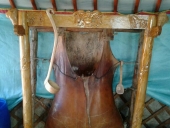By request, I've started this thread to explain how to make milk and water kefir and try to answer to my best ability any questions about kefir. Kefir is a fermented drink, made to cultivate beneficial bacteria that makes for a happy gut. It's easy to make, and anyone can do it. I got my kefir grains for making milk kefir from
The Kefir Lady. It's one of those things that you really only have to buy once, and you can keep them alive indefinitely. I make my kefir using raw cows milk I get from a local farm, but it can also be made using goats or sheep milk. The woman running the farm has two Jersey cows she milks every day. Kefir can be made from pasteurized grocery store milk, but I'll be the first to tell you it just ain't the same. I tried it once when I couldn't get
raw milk and never did it again. The flavor and texture is very different and I personally found it unpleasant. Here's how I make my milk kefir, and I make a pint a day:
1: Each morning I pour cold milk from the fridge into a pint mason jar, and set that in a bath of hot water from the faucet to warm it up.
2: Once the milk is no longer cold, add kefir grains and stir.
3: Cover with a breathable cloth and rubber band. Leave the jar out at room temperature. Kefir fermentation off-gasses, and if a lid is screwed on the jar will explode.
4: After 24 hours, strain using a wire mesh strainer and
spoon to separate the kefir grains from the now kefir. What was liquid milk will now be a gelatinous globule, which readily breaks apart and easily goes thru a wire strainer with a little stirring. It'll take a minute or two to get it all thru the strainer. Put fresh kefir in fridge.
5: Repeat steps 1 thru 4.
I refrigerate my milk kefir as I like to drink it cold, though it's ready to consume when finished. The kefir grains will grow, so every couple days I take some out. I could leave them in, and add more milk and make a quart a day or more, but I like the pint a day schedule for myself.
Out of milk? Going on vacation? Put the kefir grains in a clean mason jar, add
distilled water to cover the grains, and put them in the fridge. They'll go dormant and last for a few months.
Water Kefir:
Making water kefir is essentially the same process as the milk kefir, but takes a little longer. I purchased my water kefir grains from
Kombucha Kamp. I make a quart of water kefir at a time, which is the appropriate volume to make with the amount of water kefir grains in one package they sell. A key here is to use distilled or reverse osmosis water or quality well water. Crap in municipal water will kill the kefir grains. Here's how I make my water kefir:
1: Bring distilled, reverse osmosis or quality well water to a boil.
2: Pour about a cup of water into a glass pyrex measuring cup.
3: Add 1/4 cup of organic raw cane sugar along with about a teaspoon or organic unsulphured molasses.
4: Stir until sugar and molasses are fully dissolved and incorporated, about 30 seconds.
5: Let cool.
6: Pour sugar solution into quart mason jar, and fill jar with distilled, reverse osmosis or well water, leaving about a 1/2 inch of head space.
7: Add water kefir grains.
8: Cover with breathable cloth and rubber band and leave out room temperature for four days. If you screw a lid on the jar, you guessed it, it will explode.
9: Pour finished water kefir thru a wire mesh strainer to separate the grains from the now water kefir. Refrigerate water kefir.
10: Repeat steps 1-9
Making kefir is really easy. I have found the kefir grains to be pretty hardy and can take some abuse, like forgetting to strain the milk kefir and doing it the following day, making 2 day kefir. It's extra tangy. And to be totally honest, I've unintentionally made 3 day kefir. Woooo!!! Sour!!! I drank it anyway. I've spaced out and left the water kefir on the counter top for an entire week. You guessed it, the flavor has some extra wang to it. :) If I'm scrambling to get out the door in the morning and realize I hadn't made my milk kefir (morning is when I make mine every day) I'll toss the whole jar, grains and all, in the fridge so slow down the ferment to keep it from getting extra tangy, and then strain it the next morning. I've never made myself sick or even had an grumbly belly resulting from multi day milk kefir or week long fermented water kefir.
Any questions? I'll try to answer!

 5
5








 2
2








 1
1
























 1
1








 1
1




 1
1




 2
2




 1
1




 1
1




 1
1




 1
1








